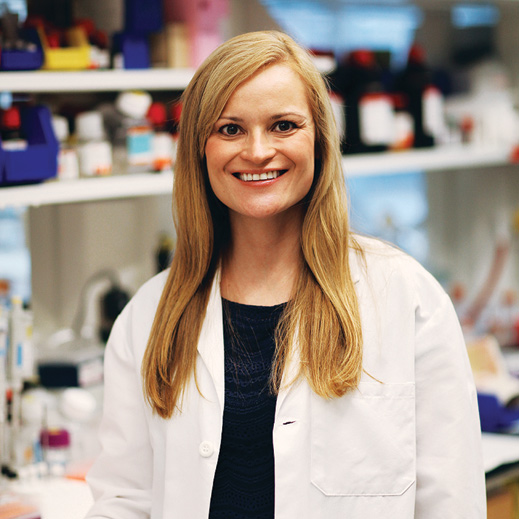Why I Rallied MIT Postdocs
When I became a postdoctoral associate at the Koch Institute in 2009, I was thrilled to be at MIT with all these brilliant minds. Every time I went on the MIT website, I read about another discovery being made, another cool startup in the works. But I soon discovered that the only people I got to interact with were in my lab.

I looked for events that would get postdocs together but found very few. In medical school at Wake Forest, I’d served on a very active graduate student association. And although MIT has a similarly vibrant Graduate Student Council, it had no equivalent organization for postdocs. Our only option was to attend the monthly meetings of the Postdoc Advisory Committee (PAC) run by the provost’s office. While no one doubted that the provost had our best interests at heart, postdocs weren’t really setting the agenda at PAC meetings. The few who did attend were showing up to vent—and eat the free lunch.
No longer students, not yet faculty, but not exactly staff, either, postdocs are caught in the middle, navigating a period of transition that ranges from one to six years. They face unique challenges that often don’t get addressed by a student, faculty, or employee group. And with more than 1,400 postdocs at MIT spread across 50-plus departments, laboratories, and centers, it was hard to even find each other, let alone speak with a united voice.
In 2010 I attended the annual conference of the National Postdoctoral Association and found out that many universities have postdoctoral associations with elected officers and active members who organize social events, professional development programs, and other activities. Why couldn’t we do the same?
Back at MIT, as we were splitting cell lines in the cell culture room, I told two postdocs in my lab about the conference and floated the idea of starting an MIT postdoc association. “This is MIT,” my lab mate Ana Jaklenec replied. “We don’t need anyone’s permission. Let’s just do it.”
I raised the prospect at a PAC meeting, where we discussed how it might work. We’d need a budget, funding, bylaws. And we’d need time to promote the idea and get support from the faculty and the administration. None of us sitting around the table would have guessed it would take the better part of a year to get the new MIT Postdoctoral Association (PDA) off the ground.
First I met with Hazel Sive, associate dean of science, and then with Claude Canizares, who was then vice president of research and associate provost. They both immediately supported our proposal and had me present it to the provost, the deans, the faculty, and President Hockfield. President Hockfield told me that postdocs needed a voice in the MIT community and that she was glad to see us taking the initiative.
There were twists and turns along the path. I had some postdocs tell me to forget about starting the PDA and form a union instead. “That would show them,” one said. But in the end we just had to give everyone time to warm up to the idea.
The PDA officially launched in September 2011, on National Postdoc Appreciation Day. At his annual postdoc appreciation lunch, Canizares introduced me as the founding president of the new organization. I told the postdocs about our purpose and introduced the other founding officers. And then we invited postdocs to speak their minds.
On a giant whiteboard, we made two columns: “What I like about being a postdoc at MIT” and “What I wish was different as a postdoc at MIT.” Before we could blink, the “What I wish was different” side was full! We heard about the hassles of getting international visas, the prohibitive expense of gym memberships, the lack of benefits for postdoctoral fellows, the dearth of opportunities for connecting with other postdocs, and more. Within a year, we had obtained access to career services at the writing center, negotiated affordable rates for athletic memberships, gotten postdocs on numerous MIT presidential committees, and secured access to the Infinite Connection for postdoctoral alumni. We also organized at least a dozen social functions and professional events for postdocs.
Ana had said “Let’s just do it.” So we did.
Founding PDA president Paulina Hill was a postdoctoral associate for two years in the Langer Lab at the David H. Koch Institute for Integrative Cancer Research, where she’s now a research affiliate.
Keep Reading
Most Popular
Large language models can do jaw-dropping things. But nobody knows exactly why.
And that's a problem. Figuring it out is one of the biggest scientific puzzles of our time and a crucial step towards controlling more powerful future models.
The problem with plug-in hybrids? Their drivers.
Plug-in hybrids are often sold as a transition to EVs, but new data from Europe shows we’re still underestimating the emissions they produce.
Google DeepMind’s new generative model makes Super Mario–like games from scratch
Genie learns how to control games by watching hours and hours of video. It could help train next-gen robots too.
How scientists traced a mysterious covid case back to six toilets
When wastewater surveillance turns into a hunt for a single infected individual, the ethics get tricky.
Stay connected
Get the latest updates from
MIT Technology Review
Discover special offers, top stories, upcoming events, and more.